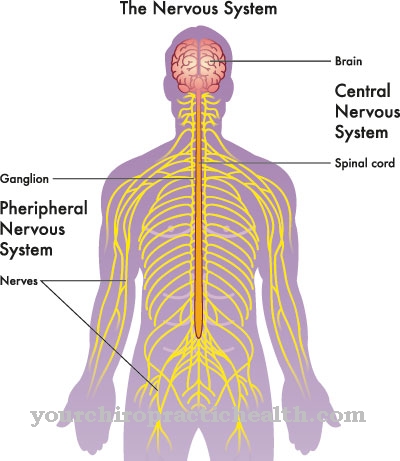Type 2 diabetes mellitus is often caused by being overweight. The disease can often be controlled through consistent behavioral measures.
What is Type 2 Diabetes Mellitus?

Type 2 diabetes mellitus is a form of the chronic disease that is colloquially known as diabetes and affects the metabolism.
Characteristic of diabetes forms such as type 2 diabetes mellitus is an increased blood sugar level in those affected. The term diabetes for forms of diabetes, such as type 2 diabetes mellitus, is based on the fact that sugar can be detected in the urine of people with diabetes.
Type 2 diabetes mellitus mainly affects older people. For this reason type 2 diabetes mellitus was also called in the past Adult diabetes designated. However, type 2 diabetes mellitus is also becoming increasingly common in younger people. Science justifies this in the fact that more and more children and adolescents are eating unhealthily and too much. In addition, many children suffer from a lack of exercise. Both components then usually lead to obesity and subsequently to diabetes.
Type 2 diabetes mellitus makes up by far the largest proportion of diabetes diseases worldwide. The number of people affected by type 2 diabetes mellitus is increasing.
causes
Type 2 diabetes mellitus is based on impaired production of insulin by the pancreas and the impaired action of insulin in the body.
Due to impaired insulin production in type 2 diabetes mellitus, those affected experience an inadequate release of insulin after ingesting food; this can then trigger an acutely elevated blood sugar level. A so-called insulin resistance in type 2 diabetes mellitus means that body cells react only to a limited extent or not at all to released insulin and thus the breakdown of glucose in the blood is impaired.
In type 2 diabetes mellitus, there is a so-called relative insulin deficiency: Despite insulin production, the insulin does not cause sufficient reactions in the body cells. The majority of people with type 2 diabetes mellitus have risk factors such as high blood pressure and being very overweight.
Symptoms, ailments & signs
In contrast to type 1 diabetes, in which symptoms appear within a few weeks, type 2 can creep in unnoticed for years. Although the symptoms are partly similar, they are often delayed and less severe or are not assigned to diabetes mellitus straight away. It is not uncommon for the blood glucose test to contribute to the final diagnosis.
Nevertheless, frequent urination and increased thirst are typical symptoms that occur when the body tries to get rid of too much sugar in the blood through the kidneys, even with type 2 diabetes. Fatigue, exhaustion and poor concentration become noticeable.
If the disturbed energy and fluid balance progresses, the skin dries out. Weight changes, headaches, muscle cramps, visual and erectile dysfunction as well as tingling and numbness in the hands and feet can also occur. The immune system is also affected. Recurring infections such as bladder and gum infections, fungal infections or colds and poor wound healing are among the typical symptoms of diabetes.
If type 2 diabetes is not treated, further acute symptoms will occur. The increased urine output can lead to dehydration and kidney failure. Finally, nausea, vomiting and impaired consciousness herald a diabetic coma - a life-threatening high blood sugar level. If type 2 diabetes has already been recognized and is treated with insulin or medication, dangerous hypoglycaemia can occur as a result of an overdose or heavy physical exertion.
Diagnosis & course
The presence of type 2 diabetes mellitus can be determined from the blood sugar levels.
In addition, a urine sample can show glucose in the urine in type 2 diabetes mellitus. Indications of type 2 diabetes mellitus are given if, for example, blood sugar levels of more than 110 mg / dl are found in the whole blood in the fasted state; in healthy people this value is usually below 90 mg / dl.
The course of type 2 diabetes mellitus depends primarily on consistent therapy. With appropriate medical treatment and the active cooperation of the patient, the prognosis for type 2 diabetes mellitus can be very good. If type 2 diabetes mellitus is not adequately treated, consequential damage can lead to restrictions in quality and duration of life.
Complications
In the course of diabetes with type 2 diabetes mellitus, acute and long-term complications can arise. Acutely, an increased blood sugar level causes a derailment of the sugar metabolism. This can lead to a diabetic coma with circulatory collapse and loss of consciousness.
Hypoglycemic shock can cause hypoglycemic shock, which manifests itself in typical symptoms such as sweating, tremors and palpitations. If not treated, the mind lock follows and finally the circulatory collapse. As a result of a chronic illness, secondary diseases of the organs can occur.
The kidneys, nervous system, heart and blood vessels, and eyes are all affected. Sexual disorders, amputations and mental illnesses are also possible long-term effects of diabetes with type 2 diabetes mellitus. In addition, many diabetics are also overweight, high blood pressure and poor blood lipid levels, which in turn are associated with serious complications.
Over the years, this can lead to calcification of the arteries and, as a result, to a heart attack or stroke. If the kidneys are affected, diabetic nephropathy with increasing protein deficiency and malignant kidney changes can occur. It can also lead to severe nerve damage to the sensory and autonomic nervous system.
When should you go to the doctor?
Type 2 diabetes mellitus is often discovered during routine examinations. Very often the disorder affects people who are considerably overweight and who are also suffering from other illnesses as a result of this.
If diabetes mellitus is suspected after a routine examination, the patient should visit a specialist, preferably a diabetologist, to clarify the suspicion and to find out about treatment options. As soon as the best possible therapy for the patient has been determined, the patient can also be looked after by the family doctor.
In addition, people who belong to a risk group or who notice certain symptoms should have their blood sugar level tested. Type 2 diabetes mellitus manifests itself through a number of signs. Weight changes that do not result from a change in lifestyle, severe thirst and frequent urination as well as constant itching are typical.
Many patients also suffer from general weakness, loss of appetite, headache, nausea and dizziness. Anyone who observes several of these symptoms at the same time and this for a few days or repeatedly, should consult a doctor promptly.
If type 2 diabetes mellitus is not properly treated, not only is the disease associated with a loss of quality of life, but life expectancy is usually also reduced. Medical care is therefore indispensable in the case of diabetes, even with the less dangerous type 2, and should take place promptly.
Doctors & therapists in your area
Treatment & Therapy
Possible therapeutic steps for type 2 diabetes mellitus can be presented as so-called step therapy: If type 2 diabetes mellitus is diagnosed in good time, step 1 therapy is often possible without the administration of medication; Interventions can be made here, for example, through a healthy diet, weight loss and physical exercise.
If therapy goals of level 1 cannot be achieved or if these are not sufficiently effective, then medication may be necessary at level 2 of the therapy of diabetes mellitus type 2; medication for overweight patients with type 2 diabetes mellitus is usually different from medication for patients of normal weight. If therapy level 2 in type 2 diabetes mellitus is not successful, additional medication can be prescribed at level 3.
At stage 4 of the therapy of type 2 diabetes mellitus, the previous administration of medication is supplemented by an administration of insulin. In the last stage of the treatment of type 2 diabetes mellitus, the therapy finally focuses on the administration of insulin.
Outlook & forecast
Type 2 diabetes mellitus is an incurable disease and therefore has an unfavorable prognosis. Nevertheless, it can be brought to a standstill under optimal conditions.
Without medical treatment, numerous unpleasant and debilitating side effects occur. In addition, the general life expectancy is significantly reduced. Complications that occur can be alleviated through medical progress and the cooperation of the patient. Avoiding certain risk factors can also prevent the occurrence of side effects or significantly reduce their intensity.
With sufficient exercise and a healthy diet, the patient's quality of life can be significantly positively influenced. Monitoring the blood sugar level, the blood lipid value and the blood pressure helps to be able to intervene as soon as possible in the event of changes.
Overweight patients can extend their average life expectancy as they lose weight. With a special diet suitable for diabetics, the progression of the disease can be slowed down. The patients achieve better mobility through weight loss.
In addition, the blood sugar level drops automatically. In favorable cases, type 2 diabetes mellitus can stagnate through correct behavior in everyday life. A relapse and, in this case, a progression of the disease is possible at any time with an unhealthy diet, weight gain or discontinuation of medication.
prevention
Diabetes mellitus type 2 can be prevented in many cases through a healthy lifestyle; This includes, for example, a balanced diet (low in fat, sugar and sufficient vegetables, fruit and whole grain products), regular physical activity and, above all, avoiding obesity. If you need support in preventing type 2 diabetes mellitus, a visit to a doctor can be helpful.
Aftercare
Type 2 diabetes mellitus does not require traditional follow-up care, but lifelong medical supervision. After diagnosing and stopping medication and / or injections, the patient must see their doctor at regular intervals. He will keep checking the values, both those obtained in the practice and those that the patient himself has taken between visits to the doctor.
Furthermore, nutrition training is indispensable for most diabetics. Here you will learn about the right diet and the benefits of exercise. Often times, a doctor's office that specializes in diabetology also has a nutritionist. The patient should also meet this regularly.
The rhythm could, for example, look like this: an appointment with the doctor and the nutritional counseling service alternately every three months. If the disease is more advanced, you will likely see more doctor visits. Annual examinations by the ophthalmologist and podiatrist (specialist in feet) should also be part of the patient's preventive care program.
As diabetes can affect eyesight, an ophthalmologist visit is essential. Diabetes is a progressive disease that cannot yet be cured. In addition to the right lifestyle, preventive medical check-ups are an important component in slowing down the process.
You can do that yourself
If type 2 diabetes mellitus is associated with obesity, the most important contribution that those affected can make to self-help is a change in their lifestyle and eating habits. Remission can very often be achieved by losing ten kilograms.
Affected people who have already carried out several weight loss diets in the past that have not shown lasting success should definitely seek professional support. In preparation for a weight-loss diet, it is helpful to note down what was eaten when and in what quantities over a period of at least two weeks. The diet diary makes it easier for an ecotrophologist to identify counterproductive foods and harmful eating habits. Such a diary is a good means of self-control during the diet.
Very often those affected lack the motivation to make a comprehensive change in lifestyle and eating habits. Diabetics should then team up with other sufferers and join a self-help group. Many people are also motivated by aspects that are not primarily of a health nature, but rather focus on higher goals, such as animal and environmental protection or global nutritional justice. Anyone who can motivate themselves through idealistic goals should deal with the advantages of a plant-based vegetarian or vegan diet.
Regular exercise is also important. If there is a lack of motivation, membership in a fitness studio is worthwhile, where individual exercise plans are created and monitored by the trainer.



.jpg)









.jpg)

.jpg)
.jpg)











.jpg)